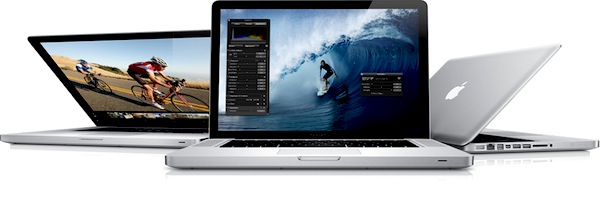Apple celebrates Steve Jobs' birthday with dual- and quad-core MacBook Pros

Today, Apple finally brought MacBook Pro up to speed with Windows laptops. After skipping the last generation of i Core chips, Apple adopted new Intel "Sandy Bridge" processors for some MacBook Pro models. In a surprising, but rumored move, Apple swapped out nVidia graphics for integrated Intel and AMD graphics. Apple updated all three MacBook Pro lines -- 13.3-inch, 15.4-inch and 17-inch. Apple also introduced a new peripheral port called "Thunderbolt."
The new configurations represent hefty upgrades across the board -- for example, bumping up storage capacity in the entry level MacBook Pro from 250GB to 320GB and doubling the memory on some other models. However, in a disappointing move, Apple did not upgrade 13-inch models' display resolution from 1200 x 800 to match MacBook Air's 1366 x 768.
The move to Intel graphics is surprising. Apple stunned some Apple Watchers by choosing older Intel dual-core processors for new MacBook Air models released last year. Many analysts cited graphics as major reason -- that Apple preferred nVidia discreet graphics to Intel's integrated option. Now, suddenly, Apple has switched to get i Core processors.
Apple apparently chose Intel's Thunderbolt over some other connectors, including USB 3.0, for which peripherals already are available (I own a LaCie USB 3.0 external drive). Apple and Intel claim bi-directional throughput of 10Gbps. The port also can connect to HDMI, DVI and VGA displays.
Like before, the 13-inch model is available in two configurations, selling for $1,199 and $1,499. The lower-cost model comes with 2.3GHz Intel Core i5 processor (dual core); 13.3-inch display with 1280 x 800 resolution; 4GB of DDR3 memory; 320GB 5400-rpm hard drive; SuperDrive (DVD combo); Intel HD 3000 graphics; two USB, one FireWire 800 and one Thunderbolt port(s); SDXC card slot; 802.11n WiFi; Bluetooth 2.1 + EDR; FaceTime HD Webcam; Mac OS X "Snow Leopard;" and iLife `11. The higher-end model swaps out the processor for 2.7GHz Intel Core i7 (dual core) and bumps storage to 500GB. Apple also offers 128GB, 256GB and 512GB solid-state storage options. Which, respectively, add $200, $600 and $1,200 to the purchase price. Additionally, buyers can bump memory to 8GB for $200 more.
The two 15.4-inch MacBook Pro models sell for $1,799 and $2,199. The lower-cost model comes with 2GHz Intel Core i7 processor (quad core); 15-inch display with 1440 x 900 resolution; 4GB of DDR3 memory; 500GB 5400-rpm hard drive; SuperDrive (DVD combo); Intel HD 3000 and 256MB AMD Radeon HD 6490M graphics; two USB, one FireWire 800 and one Thunderbolt port(s); SDXC card slot; 802.11n WiFi; Bluetooth 2.1 + EDR; FaceTime HD Webcam; Mac OS X "Snow Leopard;" and iLife `11. The higher-end model swaps out the processor for 2.2GHz Intel Core i7 (quad core) and bumps graphics memory to 1GB with AMD Radeon HD 6750M chip and storage to 750GB. Apple also offers 128GB, 256GB and 512GB solid-state storage options. Which, respectively, add $200, $600 and $1,200 to the purchase price. Additionally, buyers can bump memory to 8GB for $200 more.
The single 17-inch model, selling for $2,499, comes with 2.2GHz Intel Core i7 processor (quad core); 17-inch display with 1900 x 1200 resolution; 4GB of DDR3 memory; 750GB 5400-rpm hard drive, SuperDrive (DVD combo); Intel HD 3000 and 1GB AMD Radeon HD 6750M graphics; two USB, one FireWire 800 and one Thunderbolt port(s); SDXC card slot; 802.11n WiFi; Bluetooth 2.1 + EDR; FaceTime HD Webcam; Mac OS X "Snow Leopard;" and iLife `11. Apple also offers 128GB, 256GB and 512GB solid-state storage options. Which, respectively, add $100, $500 and $1,100 to the purchase price. Additionally, buyers can bump memory to 8GB for $200 more.
Apple CEO Steve Jobs turns 56 today. Happy birthday, Mr. Jobs.